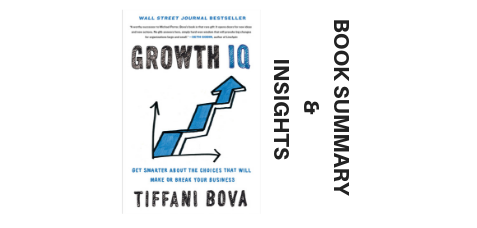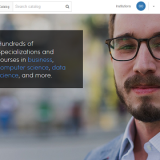Growth IQ (2018) Book Summary & Insights
Book Title: Growth IQ
Subtitle: Get Smarter About the Choices that Will Make or Break Your Business
Publication Date: 2018
Author Name: Tiffani Bova
About The Author
Tiffani Bova is Growth Adviser in Global Customer Growth and Innovation at Salesforce. She has extensive experience advising business leaders about emerging trends in business, innovation, and customer growth issues; through her “What’s Next!” series of podcasts.
Book Summary
Every business seeks purposeful growth. A good deal fail at it; only a small fraction succeed after a series of trial and error. What if you could sit with a business guru who would help clarify your thinking and point your business toward growth in ten, easy-to-digest concepts? What if this business guru cited cases involving both startups and established businesses in bringing these concepts to life?
In “Growth IQ: Get Smarter About the Choices that will Make or Break Your Business”, author Tiffani Bova walks business leaders desiring growth through ten time-proven paths to achieving it. Tiffani introduces you to each path, the opportunities walking down each path; and the pitfalls. There’s a lot of examples of startup and established businesses who have walked down those paths to learn from.
Who Is This Book For?
Start-up business owners, Business Leaders at the “C” and Functional Levels, Management Cadre Staff Responsible for Crafting Strategy, and Entrepreneurs
Buy Book: Support The Book Author And Our Work
Great books should be read, studied, and reviewed frequently, so reading the actual book may provide more value to you than the book insights on this page. Besides, this would support the work of the book author(s) and what we do on LarnEdu. What could be better?
Important Notes
We get a small compensation from Amazon when you visit your nearest/local Amazon site via our affiliate link to purchase an item within 24 hours or if you add it to your cart and checkout within 90 days. This is no additional cost to you and supports our work.
The information on this page is meant to supplement the actual book(it is not a book review but distils the key insights or ideas from the book in under 5000 words). The content creator or LarnEdu does not necessarily support the views, thoughts, and opinions expressed in the text/book. Reasonable skepticism should be applied with any views, thoughts or opinions expressed/shared by the book author or content creator.
Reading the contents of this page does not guarantee specific results. The best lessons are achieved from taking consistent action in the real world rather than being addicted to the illusion of progress by getting stuck on reading an infinite amount of books or book summaries and insights. LarnEdu and the content creator accepts no responsibility or liability for the accuracy of the information on this page or how it is used.
Book Insights

Introduction
Businesses, whether startups or already established ones, require a fresh spurt of growth. Several theories for achieving this growth abounds. But how best does a business chasing growth proceed?
In this book, Tiffani Bova, who has had extensive experience working on the question of business growth, advice on ten paths businesses can take as they seek growth. You can take any of these growth paths, in any order and combination; what’s most important is to apply every precept enshrined in each path.
The Best Way To Grow Your Business Is To Focus On Customer Experience
The most-often repeated answer to the question of what gives a business a competitive edge is price. But is it?
Few people remember how much they spent on their last shopping. But several will remember the last time they experienced a terrible customer service. So customer experience, not price is a business’s secret to gaining a competitive advantage. This is true in this age where you can access online customer reviews. A recent research shows that about 70% of prospective customers read through reviews before deciding to buy a product. When you understand what this portends, you can take your business to dizzying heights.
Shake Shack, the hot dog fast-food chain, thrives on customer experience. Starting out in 2004 as a single hot dog cart in the Madison Square Park in New York, it has 136 locations all over the world today. We can attribute Shake Shack’s rise to its making customer experience the centrepiece of its strategy. Apart from sourcing the meat it uses in its menus from local, high quality suppliers; Shake Shack has a tradition of requiring customers to provide feedback on their experience of the brand. It also hosts a lot of customer roundtable discussions. All these aggregated into many positive reviews and posts across the Internet; all by her customers!
On the flip side, if you ignore customer experience, your business will go under. Take Starbucks for instance. Prior to 2007, the coffee company had invested in growing her stores and diversifying the menu. Then it experienced a lull in her bottom line in 2007. Feedback from its customers had a common undertone: quality was down. Starbucks had grown at the expense of quality and management had to move fast to remedy the situation! Management shut down over 7,000 stores at once for three-and-a-half-hour training sessions, and it installed premium Mastrena coffee machines in every store. Also, a promotion, “My Starbucks Idea”, launched to encourage customers to share thoughts about how the coffee chain could get better on its customer experience. Within two years of taking the decision to make customer experience a priority, Starbucks grew.
Maximise growth by focusing on penetrating your customer base
Business owners have the notion they could grow their businesses by attracting new customers. While this is true, doing it at the expense of a business’s existing customers will cause lots of challenges down the line. What’s best for a business seeking to grow is for it to continue to tend to its present customer base. It’s efficient, and it costs much less.
Going by a 2014 article published in the Harvard Business Review, it costs anything from 5 to 25 times more to gain a new customer when compared to the cost of keeping an existing one. The easy way to maximise growth from your existing customer base is to take a second look at your customer data! Their past buying behaviours can give you an accurate idea of what they like, what they need and what they dislike. A business can just focus on such data and enhance existing customers’ experience of its products, while also expanding the range of products available for them to buy. Overtime, a business’s existing customers are loyal, are more likely to try out new product offerings and are less critical when the experience falls below expectation. This is what customer base penetration is all about. But to succeed at it, a business must know its customers inside out. McDonald’s understands how to do this.
In 2006, amidst stunted growth rates, McDonald’s increased the options available on its menu, all to attract new clientele. It backfired. Because of the several items now available on the menu, the service staff could not keep up. The quality of service went down. Customer wait times increased. It was a disaster. Her management surveyed customers to understand their dining needs, and the answers surfaced. For example, customers had forever been asking for an all-day breakfast. Management implemented that in 2016. Management also cut down the sizable menu. These changes returned the fast-food chain back on the path of growth.
Your Business Can Use Market Acceleration To Chase After New Growth Opportunities.
What do you do when you’ve held down your fair share of your market and your business is thriving? Do you stay in one place and stagnate? No. This is when you need market acceleration: penetrating new markets with your products so that new customers can have access to them. It takes a well-known brand and some careful planning to achieve this. A good case in study is Under Armour.
Founded in 1995 by Kevin Plank, Under Armour sells sportswear that are not the
typical cotton sports t-shirts available then. The first product offering it
had was a synthetic shirt that kept athletes dry and cool. Under Armour
marketed this shirt to American football players, and it was a hit. Several NFL
teams patronised Under Armour. It wasn’t long before the brand became
well-known in sporting circles. Kevin Plank knew he had that the sports market
in the US locked down, but he wanted more success. By the year 2000, Under
Armour was already marketing its products in new markets in the United States.
Later, Under Armour took on the global markets. Today, Under Armour is a
billion-dollar business standing shoulder-to-shoulder with such industry giants
as Adidas and Nike. Under Armour did this by focusing first on its niche
market, establishing its core brand inside that niche market and then expanding
into new markets.
Under Armour’s case shows you need to plan if you must succeed at market acceleration. Inadequate planning or no planning at all, often leads to failure as the case of Mattel, the US toy maker shows. Over the years, Mattel had created a niche for itself in making and selling kids toys. It did well in that niche until kiddies TV shows and games eroded its share of the market in the US. To keep growing, Mattel, in 2009, sold its products in international markets. It opened “House of Barbie”, its flagship store, in the Chinese city of Shanghai. Two years down the line, the store had to be closed because of the huge losses it was incurring. Mattel found out, the hard way, that there was little or no correlation between its product offerings and the tastes of its proposed Shanghai clientele.
To Succeed In Changing Markets Expand Your Product Line
How do you keep up your business’s growth in a market that’s changing? By changing with the market! In this kind of market, forecasting the changing needs of your customers and positioning to meet those needs is the holy grail! You can achieve this by adopting a product expansion strategy. Social media influencer, Kylie Jenner, used this strategy for her cosmetics business.
In 2015, Kylie Jenner had leveraged on her sizeable social media following to
start up and run her cosmetics brand. Kylie understood that her market, the
audience that followed her on social media, had fleeting tastes in cosmetics.
So her strategy was to keep increasing the product offerings available to her
customers. She added new categories of products like eye shadows and eyeliners.
Also, she shared tutorials through SnapChat. And thematic collections too.
These resulted in a revenue of about $600 million in two years of operation.
John Deere is a good example of an established business using the same
principle. The self-scouring plough was the first product it marketed in 1837
and it was a success. But then, tractors were introduced into the market by the
competition; and tractors rendered ploughs useless. So John Deere kept up by
producing tractors and combined harvesters. Then it commissioned Salesmen to
seek its customers and glean their needs from them. It incorporated this
knowledge into the design of the company’s next generation of products.
For the business that refuses to keep up with the changes in its market, failure is not so far off. Blockbuster, for example, made an outstanding success of its movie rental business. But then it refused to change its business model even as its marketplace kept changing. Traditional movie-rental customers were embracing alternate ways of renting movies, but Blockbuster paid no heed to that. That gave room for an upstart like Netflix to take over the market for movie rentals, using a mail-order model that customers found convenient. By the time Blockbuster realised its oversight, it had lost its dominance of the movie rental market.
Diversifying Customer Base and Product Offerings Is Often Risky And Costly For A Business, But The Potential Payoff Makes It Worth The Effort
What does a business do when product expansion and market acceleration strategies have grown it, but then that growth stalls? The time might just be right to try out a customer and product diversification strategy. To use this strategy, think through what product (s) you are selling and to whom you are selling to in the marketplace.
Look at the example of Marvel, the publisher of comic books that started
business in 1939. By 1993, business was down. No one wanted the company’s comic
books or trading cards. By 1996, Marvel filed for bankruptcy so it could
restructure its debts. Fast forward to 1997 and Marvel Inc morphed into Marvel
Enterprises Inc. After an initial hiatus, there was a realisation that what
made the Marvel brand of comic books valuable was not the comic books
themselves, but the characters inside. Realising this, Marvel Enterprises Inc
decided that diversifying to play in a new market, movies, would make business
sense. So the company borrowed money and made her movies by herself. Marvel
Enterprises’ first major movie hit was in 2008 with the release of Iron Man.
One year after, Disney bought Marvel Enterprises for four billion dollars!
Marvel’s happy ending does not take away the risks inherent in diversifying a
customer base or a product offering. Lego, which specialises in making toys,
once tried out diversification in the late 90s. The plan was to market the
company’s products in several markets at once–computer games, theme parks,
clothing; etcetera. That did not work. Lego ended up spreading her resources
too thin as it tried to be present in several markets at once. It had no choice
but to revert her operations back to its initial status in the early 2000s.
Lego soon returned to growth after pruning its sizable staff, slimming down its
bureaucratic ranks and ridding itself of unprofitable products.
Optimise Your Sales Process So Your Customers Can Buy Your Products With Ease
It’s not enough to have good products to sell or customers to sell them to. You also need to know how to sell your product offerings. This is what the “optimising sales” strategy is about. You want every customer that interacts with your brand to have a happy experience doing so. One easy way to do this is to integrate information technology into your sales process. Your customers will find it easy to patronise you. Walmart did this in 2016 when it bought jet.com. The move also readied Walmart for coping with the challenges Amazon’s move into the groceries market brought when it bought over Whole Foods.
Understand that the optimising sales is not the same as selling more. Aiming to sell more just for the sake of selling will hurt a business. Wells Fargo has been in banking since 1852. After being steady and conservative in its business dealings for 150 years, the bank upped the ante by selling more of its products, for example, customer accounts. Before long, competitive sales was the dominant culture in the bank. It pressured every staff to sell. In 2016, PR scandals broke out. Bank staff had been unethical in their dealings as they sought to sell. For example, they opened about 3.5 million customer accounts between 2009 and 2016 without the account holders’ knowledge!
Minimising The Rate At Which You Lose Customers Is More Important Than Gaining Winning Over New Customers
Even though it‘s a valid business growth strategy to win over new customers, it’s way more expensive than keeping existing ones. Good customer retention is the cheap way to keep business growth on track. Every business will experience customer churn, but businesses should keep it at its minimum through improvements in product quality and customer experience.
Spotify does this in two ways. One, there are several account types a new user
can choose from. Then there is the option to downgrade from one account type to
another, maybe a more affordable one. This way, Spotify can achieve high
customer retention rates on her platform. Netflix is another company that does
this well. By creating its own video content and selling them only on its
platform, it’s able to keep the bulk of its customers who prefer unique video
content to the generic content the competition offers.
When a business experiences churn, it shows underlying problems. Blue Apron,
founded in 2012, sells pre-packed food ingredients and accompanying recipes to
her customers so they can create home-baked meals. It also diversified into a
wine subscription service. On the surface it would seem the company was
growing; but that growth is being mitigated by a high rate of customer churn.
The quality of its deliveries are not consistent and deliveries arrive late
most times or not at all; so unsatisfied customers keep leaving the service.
Grow Your Business Faster By Engaging New Partners
Partnerships are a great tool for growing your business. Whether you are launching your products in new markets or creating new product categories, doing it with partners makes it less complicated and cheaper. For example, if you are trying to launch (sell) your products in new markets, it makes sense to collaborate with a retailer that already exists in that market. This way, you get to save up on precious time and on often lean resources.
GoPro, founded in 2004, manufactures action cameras and sells them in BestBuy stores; in a mutually beneficial partnership arrangement. GoPro gets to sell its cameras nationwide while BestBuy gets an influx of a new category of customers to which it can up-sell or cross-sell to into her stores. GoPro also had a similar branding partnership with Red Bull in 2016.
Trust is a key attribute required for partnerships to work. Without trust, partnerships soon become business liabilities. In 2003, Apple almost lost its music artist partners (and hence its very much profitable iTunes business) when it offered three-month free trials of the service to new subscribers. The music artists who owned the body of work in the iTunes store wondered if Apple would pay them royalties for those trial periods. Apple resolved the situation by committing itself to pay artist royalties during customer trial periods.
Sometimes Entering An Alliance With The Competition Is The Way To Grow Your Business.
You are used to thinking of business as a winner-takes-all competitive world. Sometimes it will be expedient for you to enter into some partnership with the competition. The concept is known as “coopetition”, a mishmash of “cooperating with the competition”. It happens in the car industry. Because of the sheer size of the industry, it’s impossible for just one car company to start a substantial change in the industry. So car companies often resort to coopetition.
For instance, in 2017, Fiat-Chrysler, BMW, Intel and Mobileye “coopetited” to
work on self-driving technology. They brought Fiat-Chrysler into the
partnership at the last moment because of the need to have a car company that
understood how best to mass-produce cars. Note that Fiat-Chrysler and BMW are
competitors. Another good example of “coopetition” in the car industry is Tesla
(the electric car company) finding it expedient to release all of its patents
to the industry. It makes good business sense for Tesla when you consider that
when electric cars become mainstream, the dominant maker of electric batteries
and charging stations (Tesla) will benefit the most.
Understand that partnerships between natural competitors are not everyday occurrences, so there is still a need to thread with caution.
Use Unconventional Strategies To Grow Your Business; And Know When To Chase Down New Opportunities For Growth
We can classify businesses into two broad types: those that just sell their
products and those that see their businesses as opportunities to be change
catalysts in their markets. The latter always use unconventional strategies in
achieving their extraordinary business goals.
One such an unconventional business is Toms Shoes, a 2006 startup that uses “conscious capitalism” to achieve its business goals. Toms Shoes opened for business with a unique mission: it would give out a pair of shoes, for free, to a child who could not afford it for every pair it sold to a paying customer. No doubt its unique business mission resonated with its prospective customers and it could win over many of them into paying for one or more pairs of shoes. In about six years after opening its first shop, Toms Shoes had an annual turnover of three hundred million dollars, had given out seventy million dollars to charity causes and provided 175,000 weeks of clean water to poor communities.
Key Quotes
Customer experience, not price is a business’s secret to gaining a competitive advantage.
It’s not enough to have good products to sell or customers to sell them to. You also need to know how to sell your product offerings.
Sometimes it will be expedient for you to enter some partnership with the competition. The concept is known as “coopetition”, a mishmash of “cooperating with the competition”.
Conclusion
The author has introduced you to ten different growth paths you can travel down
as you seek to spark growth in your enterprise–whether it’s a startup or
already established. No matter which path (s) you choose to travel, do these
three things: track the performance of your enterprise, choose your growth path
(s) only after you’ve prepared; and execute.
Since You’re Here…
Great books should be read, studied, and reviewed frequently, so reading the actual book may provide more value to you than the book insights on this page. Besides, this would support the work of the book author and what we do on LarnEdu.
You can also support the work we do at LarnEdu work by making a one/off or monthly donation(via PayPal) for as little as £0.99 or sharing this content.
Do you have any feedback or suggestions? Use the comment section below or send us a message.
Content Created By: Deji















